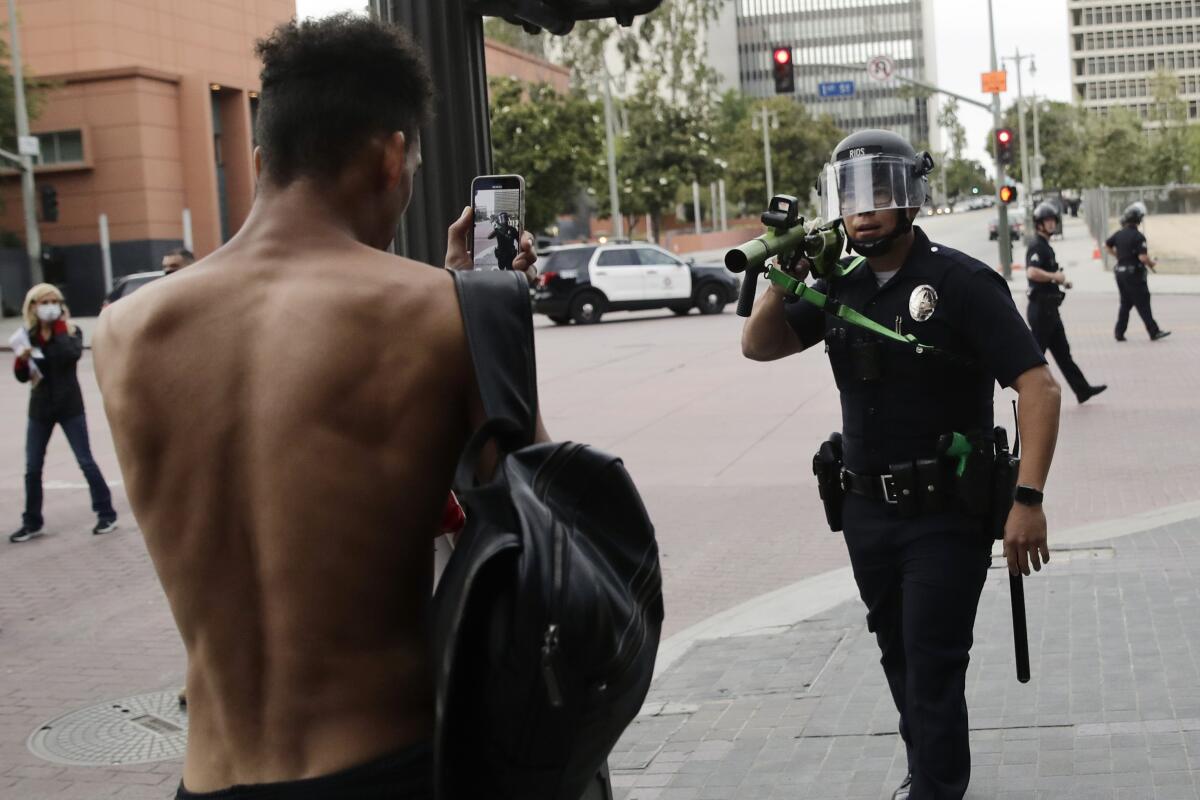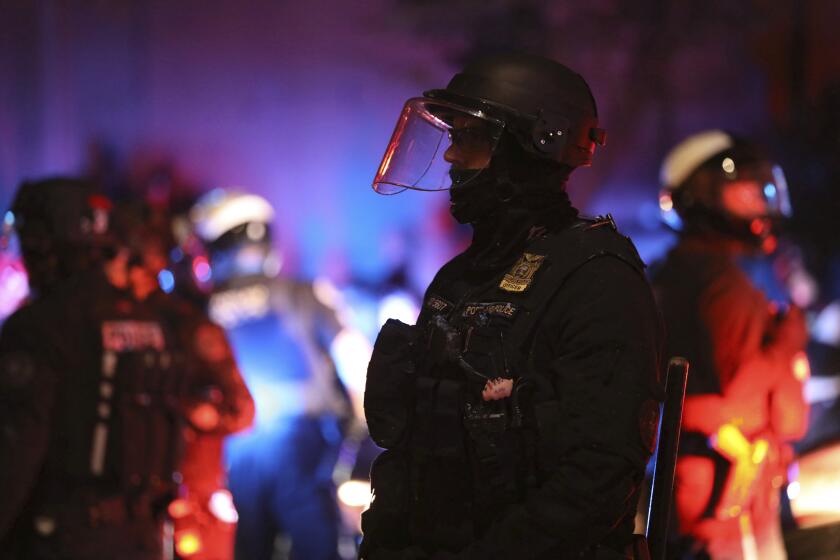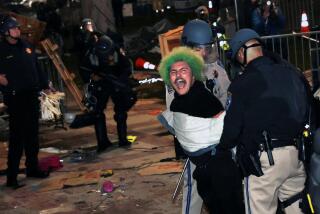LAPD’s ‘less-lethal’ projectile launchers are leading to deadly encounters, report finds

Los Angeles police officers fired 40-millimeter projectiles intended to stop people through “pain compliance” at least 133 times last year — including nine cases where civilians were also shot at with firearms, according to a department report made public this week.
LAPD officers use “less-lethal” launcher devices far more often than other big-city agencies, the report to the department’s civilian oversight commission found, renewing questions about whether they are an effective tool for subduing uncooperative individuals, as top officials have insisted. Five of the incidents where officers used both launchers and firearms were fatal.
Among the country’s five biggest police departments, only Houston and the LAPD assigned patrol officers the 40-millimeter launcher, which fires hard-foam projectiles roughly the size of a mini soda can at more than 200 mph. Houston police shot the weapons just 21 times last year, according to the report presented to the Police Commission on Tuesday.
Of the rounds fired by LAPD officers last year, about 37% led to the target being successfully subdued — compared with an “effectiveness rate” of roughly 45% in the prior three years combined when the discharges were tallied differently, the report said.
LAPD officers fired 40-millimeter rounds in at least nine of the 34 police shootings last year, compared with at least four times in 31 shootings the year before, the report found. It was not until last year that the department began counting cases in which officers fired a 40-millimeter round and missed, making comparisons with previous years difficult. The tally also doesn’t include incidents during a “crowd-control situation or riots.”
LAPD inspector general Mark Smith is a finalist for a job overseeing court-ordered reforms at the police department in Portland, Ore.
The commission asked for the report after the Feb. 3 deadly shooting of Jason Maccani by police during what his family described as a bipolar episode. Officers fired a 40-millimeter projectile and two beanbag rounds at Maccani as he walked toward them while holding what was later revealed to be a plastic fork, according to video of the incident. Moments after being struck, Maccani cried out and lunged toward the officers, which is when he was fatally shot.
The incident drew widespread condemnation from activists, city officials and former Police Chief Michel Moore, who said he had “concerns” about the officers’ actions.
At a commission meeting days after Maccani’s death, several members questioned whether officers were waiting too long before using weapons meant to avoid killing.
Maccani’s family has filed a $20-million wrongful death lawsuit against the city.
Department officials acknowledged that there was some confusion about when and how the weapons can be deployed after the passage of a recent state law. Moore, who retired at the end of February, said the department’s policy was updated late last year based on analysis of recent court decisions to allow their use against anyone who poses an immediate public safety threat. Previously, he said, such “intermediate force weapons” could be deployed when officers had reason to believe that the subject was “unsafe to approach.”
During Tuesday’s presentation, commission President Erroll Southers said he wished that the department’s study had gone further and asked why police departments in cities such as New York and Chicago weren’t deploying the launchers during day-to-day operations.
“It is noteworthy that those agencies are not using it,” said Southers, asking the LAPD to report back to the commission with those details.
Jason Maccani was going through what his relatives described as a bipolar episode when he was shot by LAPD officers at a Skid Row warehouse. Chief Michel Moore expressed “concerns” about the incident, and the department on Tuesday released video footage of the encounter.
Scrutiny of so-called kinetic weapons, such as projectile launchers or shotguns that fire beanbag rounds, has heightened in recent years amid reports of protesters suffering serious injuries after being struck.
Although 40-millimeter projectiles are commonly used elsewhere for crowd control, the Los Angeles Police Department is the largest one in the nation to use them in day-to-day operations. Normally during the arrest of a potentially combative person, officers work in teams and are each given a specific role, such as holding a ballistic shield or providing cover with a firearm or a less-lethal weapon. Officers equipped with launchers are often present at encounters with people armed with edged weapons such as knives or swords.
LAPD trains officers to aim the launchers at a person’s navel area or, if practical, their arms, hands and legs, avoiding the head, neck, spine, chest, groin or kidneys to prevent major internal damage. The launchers have an effective range of up to 75 feet and were originally used only by the SWAT team, with department-wide deployment beginning in 2016.
Often less accurate than bullets, the foam or rubber rounds are designed to spread the force of impact over a larger area, without penetrating the skin.
The Los Angeles County Sheriff’s Department also uses the 40-millimeter rounds, but doesn’t track their effectiveness, the LAPD’s report said. Neither do police in Houston, which only began using the devices in a patrol capacity in February 2023.
About 900 smaller law enforcement agencies have adopted the devices within the last two years, according to the LAPD report.
Two months after an audit raised questions about the LAPD’s helicopter program, the agency defended its nearly round-the-clock flights above the city.
Officials here, as elsewhere, have long argued that the launchers, recognizable by their fluorescent green barrel, allow for more precise targeting of violent individuals and thereby reduce serious injuries. LAPD officers fired launchers in 74 separate incidents last year, Tuesday’s report said.
But critics say referring to them as “less lethal” is a misnomer because the weapons have the potential to cause serious harm.
Attorney Carl Douglas said that officers have been known to both fire the devices indiscriminately into crowds during protests and to hesitate to use the devices in more routine encounters — creating scenarios where they resort to deadly force.
“Particularly in a mental health context and if the subject has a broom handle, for example — I have regrettably seen officers use deadly force in those occasions,” said Douglas, who has successfully sued local law enforcement agencies on behalf of people shot by “less-lethal” munitions.
Other times, he said, groups of officers have simultaneously fired handguns and “less-lethal” weapons — a trend confirmed by a Times review of nearly 50 LAPD shootings between January 2020 and April 2022.
The city has in recent years paid out millions of dollars in settlements to people who say they were seriously injured when LAPD officers fired “less-lethal” rounds into crowds of protesters.
More to Read
Sign up for Essential California
The most important California stories and recommendations in your inbox every morning.
You may occasionally receive promotional content from the Los Angeles Times.














